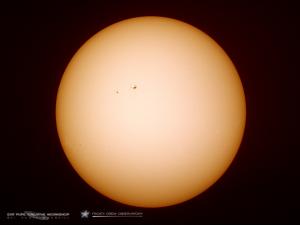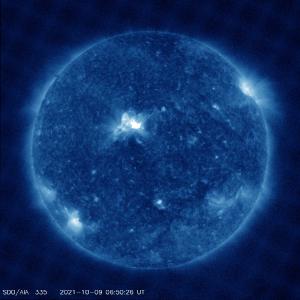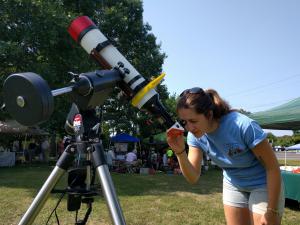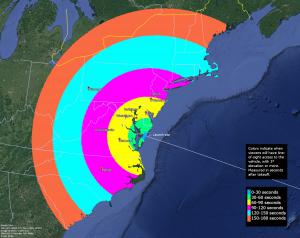Celebration of Space - March 10, 2023
Now that the winter season is coming to a close, and the Vernal Equinox is less than two weeks away, the days are certainly getting longer, making this the time of the year that we switch our clocks from Standard Time to Daylight Time, commonly referred to as Daylight Savings Time. Of course, this only applies to those who adhere to this rather archaic practice. This coming Sunday, March 12, 2023, at 2:00 am, we will switch our clocks ahead one hour, moving Southern New England from Eastern Standard Time (EST) to Eastern Daylight Time (EDT). For those who sleep at night, this will give you the shaft on one hour of sleep, for those who work the graveyard shift, you will get out an hour early, and for those who watch the sky all night, nothing will change.
We often hear people ask which way do we shift our clocks? Should we gain an hour or lose an hour? To answer that question, here is a quick mnemonic to help you remember which way to adjust your clock: In the Fall, fall back one hour, in the Spring, spring ahead one hour. Whether you set your clocks to DST before going to bed on Saturday night, or when you wake up on Sunday morning, enjoy your lost hour.
Over the past several weeks you have, no doubt, been hearing about all the flare activity that is happening on the Sun. These flares create Coronal Mass Ejections (CMEs), which may arrive at Earth and result in the Aurora Borealis. But why are we hearing about this so often now, after years of nothing?
The Sun has an 11 year solar sunspot cycle. This cycle has a period of maximum activity, called Solar Maximum, and a period of little-to-no activity, called Solar Minimum. The cycles end and start with Solar Minimum, and we can determine when the cycle changes by observing the polarity of sunspots. During Solar Minimum, the magnetic polarity of sunspots will eventually reverse. Once we observe this reversal, we know that the current solar cycle has ended and the new cycle has begun. We are currently in Cycle 25, which began in December 2019. But what is a sunspot?
A sunspot is the product of energy radiating outward and releasing from the Sun. This energy is what makes up the solar wind, and it is in a state of plasma. When energy rises from the internal atmospheres of the Sun, it travels on little pieces of solar material called granules. These granules rise through the convection zone, and flip over and release their energy when they reach the photosphere (often considered the surface of the Sun). Once the energy is released, the granule will sink back into the convection zone. Granules are magnetically charged in a dipolar manner, meaning they have a north and south magnetic pole. When granules reach the photosphere, they will often connect with other granules that are rising right next to them. This connection will allow for an independent magnetic field to form over the connected granules, which will block radiation from the surrounding regions on the photosphere. When this happens, the connected granules will start to cool, making them appear darker than the surrounding photosphere. This is a sunspot.
Sunspots are not stable, and granules that are rising beneath the sunspot start to push through. This activity, as well as other events, will cause the magnetic field over the sunspot to weaken, and eventually fail. When this happens an intense amount of energy is blasted off the photosphere. Being a plasma, the particles that are ejected are also dipolar, and will produce a magnetic push on the solar chromosphere and corona, causing a higher density plume of coronal plasma to eject into the solar wind. During Solar Minimum, these events rarely happen, but the years around Solar Maximum see this type of activity happen repeatedly.
The doomsayer and conspiracy theory communities love to freak out when Solar Maximum starts to creep in. The ideas they promote are that all this activity is going to eventually result in some catastrophic event on Earth. Fortunately, these individuals are just wrong. Solar Maximum is actually the safer time for residents of Earth, with Solar Minimum being the dangerous period. This is because, during Solar Minimum, the inactivity of the Sun keeps the solar wind rather calm and steady. This will result in Earth’s magnetic field shrinking quite significantly, allowing for an increase in cosmic rays, gamma radiation, and charged particles to enter the upper regions of Earth’s atmosphere. During Solar Maximum, the solar wind is constantly fluctuating, and Earth’s magnetic field experiences this fluctuation in waves of bombardment, which will cause Earth’s magnetic field to balloon outward, reducing the level of radiation that enters the upper atmosphere. Check out this graph created by Earth to Sky Calculus. This graph shows the level of radiation in Earth’s stratosphere by date. This radiation is relevant to travelers that fly on planes. Note the rather dramatic decrease in stratospheric radiation of late. This is happening because Cycle 25 is about 2 years away from Solar Maximum, and activity on the Sun is increasing significantly.
At Frosty Drew, we host telescopic observations of the solar photosphere and solar chromosphere on Friday afternoons from Memorial Day – Labor Day. Now that the Sun is becoming very active, there will be some amazing sunspots, prominence, and filaments that will be visible with our telescopes. So make plans this summer to stop in at Frosty Drew and see the Sun, and the next time you hear someone tell you that we are all doomed because of Solar Maximum, remind them that the good times are here.
This coming Tuesday, March 14, 2023 is Pi Day, a day for the geek inside you to come out. Pi Day will bring a lot of geeky challenges, memes, and themes, usually consisting of pie and pi. NASA JPL will host its annual Pi Day Challenge, which is an introduction to the astronomical use of Pi. Additionally, JPL will host many different activities on Pi Day. So take a moment on Tuesday to have a geek moment with our favorite ratio of a circle’s circumference to its diameter, and maybe share a tasty slice with a buddy to honor the number.
This week we will have two launches on the East Coast that could be visible to sky watchers in Southern New England. The first launch is scheduled to take place tomorrow night, Saturday, March 11, 2023, at 6:00 pm – 8:00 pm., from the Wallops Island Flight Facility in Virginia. What is launching is the Rocket Lab Electron launch vehicle. This is the second Rocket Lab Launch to happen from Wallops. Here is a visibility chart for the launch. Seeing the launch from our region should be pretty easy though a good view of the east – south horizon will be beneficial. Make sure you are out observing starting at 6:00 pm. Visibility will occur 2 – 3 minutes after launch. Since this launch is occurring right after sunset, the view could be absolutely stunning. At this time, weather is looking rather inopportune for the launch, but this could change. Let us know if you see the launch.
The second launch that may be visible to us will occur on Tuesday, March 14, 2023 at 8:30 pm. The launch is the SpaceX Falcon launch vehicle which is carrying the Dragon crew module destined for the International Space Station (ISS). The launch will not have a crew, but instead will carry equipment, science, and supplies to the ISS. The launch will happen at the Kennedy Space Center in FL., which will put visibility over our region at over 5 minutes post launch. SpaceX is not all that great at posting launch visibility maps, and likes to surprise viewers with their launches. We are unsure if this launch will be visible, but it is certainly worth a try. So set out to a location with a good view of the southeast horizon and be there for 8:30 pm on March 14th.
- Author:
- Scott MacNeill
- Entry Date:
- Mar 10, 2023
- Published Under:
- Scott MacNeill's Columns







